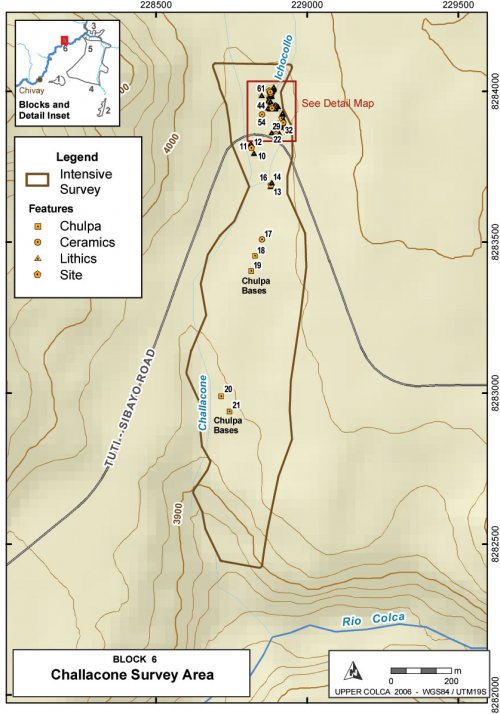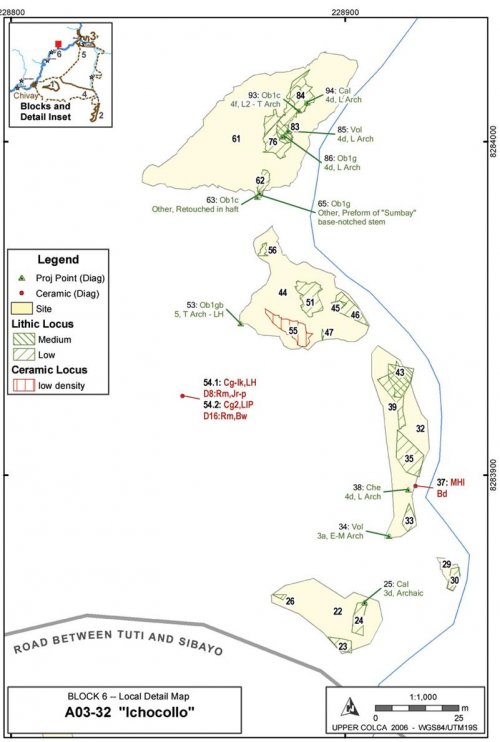A03-32 "Ichocollo" site cluster in Block 6
Approximately 10 km down stream from Block 3 a cluster of open-air sites along a tributary to the Colca was encountered in a smaller survey area called block 6. This block contains a large fraction of diagnostic Archaic projectile points along with ceramics and projectile points dating to the later Prehispanic period. In the modern geography of the region Block 6 lies immediately above the portion of the Colca valley with intensive agriculture. The Río Challacone descends from the north-east flanks of the glaciated Nevado Mismi (5556 masl) on the north side of the Colca valley, while the Ichocollo drains the south side of Cerro Chungara (5286 masl), a peak that was probably glaciated on its southern flank approximately in the same period of time as the Chivay obsidian source area contained glaciers.
|
SiteID |
FileType |
Description |
Area (m2) |
|
22 |
Site_a |
"Ichocollo 3" |
400.1 |
|
29 |
Site_a |
"Ichocollo 4" |
36.4 |
|
32 |
Site_a |
"Ichocollo 5" |
527.5 |
|
44 |
Site_a |
"Ichocollo 6" |
729.9 |
|
61 |
Site_a |
"Ichocollo 7" |
1375.5 |
Table 6-44. Site sizes in Ichocollo [A03-32].
This glaciation may have provided steady water to residents along the eastern tributary stream named Ichocollo. Today, the western of the two, the Challacone drainage, appears to be the larger stream channel and is more scoured out (see geology map in Figure 4-15), a feature perhaps related to the geologically recent large mudslide visible in the geology map as "Ladera Tinday" with the Qr-desymbology.
Figure 6-42. Block 6 Challacone - Ichocollo overview map
Figure 6-43. Ichocollo complex along Quebrada Ichocollo.
Artifacts from Ichocollo complex
Several clusters of lithics and ceramics were identified and divided into sites in this confluence area between the two drainages. The greatest density of artifacts were found on the west bank of Quebrada Ichocollo between the two streams, in an area that is relatively low lying compared to other creek banks in the zone. The area was occupied in numerous episodes in prehistory, as is evident in the diagnostic artifacts that belong to styles spanning all time periods from the Early Archaic to the Inka period. There are a number of environmental characteristics that would suggest that this area would be reused frequently in prehistory. On a local scale, the position of these sites between the two creeks perhaps provided the residents with greater opportunities in both water sources and in lithic raw materials, as cobbles occur in the creek beds. In terms of the position of this survey block in the valley, as was noted previously, the Challacone drainage is at nearly 4000 masl but it is geographically only 3 km to the east of Tuti zone that includes the warmer reaches of the Colca valley below 3900 masl and the beginning of intensive agriculture in modern landuse patterns.
A number of chert and chalcedony nodules were observed in the Ichocollo streambed and the chert was predominantly red in color and was a consistent, homogeneous material with moderately good fracture characteristics. The predominantly red-orange chert nodules in the river are evident in material used for the bifacially flaked lithics found in this site cluster, and 30 of these bifacial tools showed signs of heat treating. Relatively few of the artifacts of any material type, including chert, contained exposed cortex. One chert core had 3 rotations, and chert flakes were predominantly in advanced stages of reduction. Obsidian was of both grey and clear varieties and 27% of the obsidian in the collections had heterogeneities.
Figure 6-44. Photo looking northwest across Ichocollo creek in the foreground, the site cluster that includes "Ichocollo" [A03-32], and Challacone creek below the structure in the background.
|
Biface |
Retouched Flake |
Proj Pt |
Core |
Total |
|
|
Obsidian |
14 |
2 |
5 |
21 |
|
|
Volcanics |
3 |
1 |
2 |
6 |
|
|
Chalcedony |
1 |
1 |
3 |
5 |
|
|
Chert |
10 |
5 |
1 |
1 |
17 |
|
Quartzite |
3 |
3 |
|||
|
Total |
31 |
9 |
11 |
1 |
53 |
Table 6-45. Bifacially Flaked Lithics from Ichocollo by Material Type
|
Length (mm) |
Total |
||||||||
|
15-20 |
20-25 |
25-30 |
30-35 |
35-40 |
40-45 |
45-50 |
>50 |
||
|
Obsidian |
4 |
8 |
3 |
3 |
1 |
1 |
20 |
||
|
Volcanics |
1 |
1 |
1 |
3 |
|||||
|
Chalcedony |
1 |
2 |
1 |
1 |
5 |
||||
|
Chert |
1 |
1 |
3 |
3 |
2 |
5 |
15 |
||
|
Quartzite |
2 |
1 |
3 |
||||||
|
Total |
4 |
10 |
5 |
6 |
4 |
7 |
4 |
6 |
46 |
Table 6-46. Bifacial Lithics at Ichocollo showing Counts of Material Types by Length
An examination of lengths of bifacially-flaked artifacts from the Ichocollo area by material type shows that the immediately-available chert and chalcedony materials are found in bifaces in a range of sizes. Together with the lack of high rates of cortex, these data suggest that the Ichocollo site cluster is associated predominantly with middle-stage reduction. Potentially, decortication occurred in or near the stream bed, while middle and more advanced reduction occurred closer to the residential sites.



